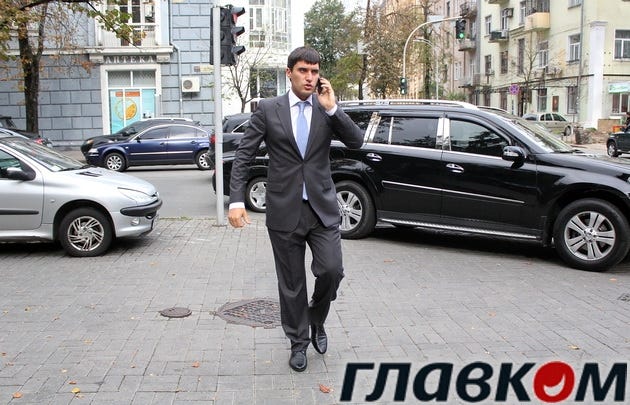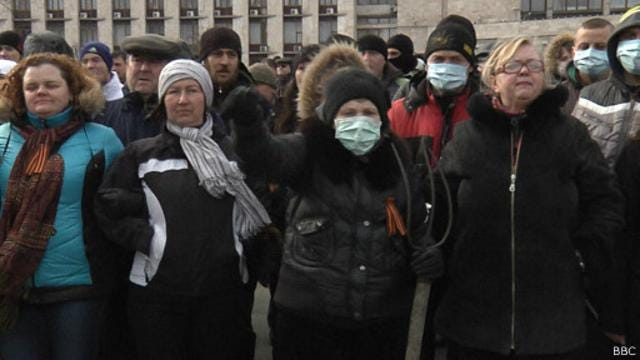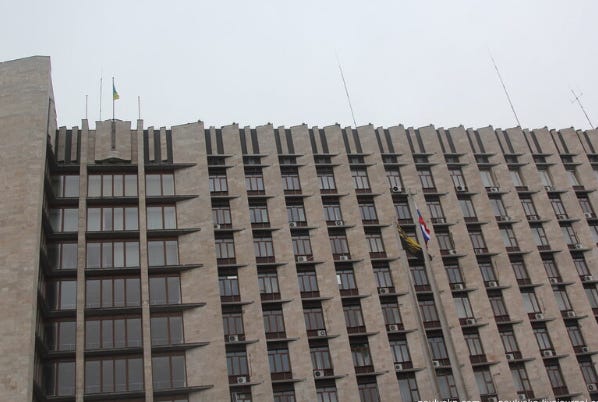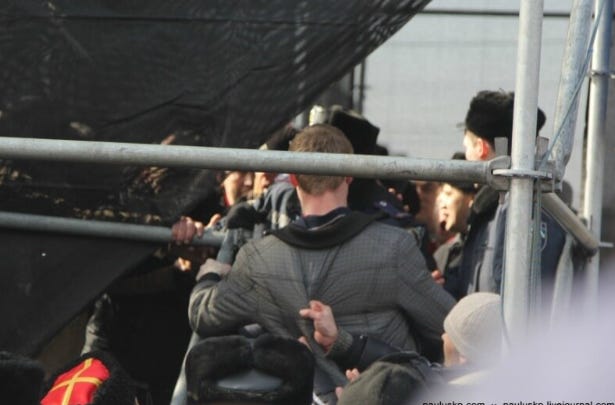Generally the western story of when the war started in Donbass focuses on Igor Strelkov. It doesn’t help that he himself supported this interpretation, famously claiming that ‘it was I who pulled the trigger of war’. But is it not natural for a military adventurist to overplay his own individual significance? In fact, many more actors were involved. The story begins just as maidan reaches its bloody victory in Kiev.
On the 20th of February in the village of Korsun’-Shevchenkovskiy in the Cherkassy area (beneath Kiev), armed maidanites stopped anti-maidan protestors in buses that were returning from Kiev to Crimea. The anti-maidanites were beaten on camera. The post-annexation Crimean government claimed on the 6th of April that 30 Crimeans disappeared and were never found, alleging the murder of seven. This incident was later named by Putin as a cause for Russian intervention into Crimea.
On the 23rd of February, residents of Donetsk guarded their regional administration from feared Ukrainian nationalists. The video of this went viral across the internet[1]. Answering questions of BBC journalists, locals said they wanted to prevent what happened in Kiev from happening there and cursed the Yanukovych government for failing them. The maidan protestors were protected by police from the anti-maidan protest, which was many times larger.
The same BBC article had this to say about the complicated relation of local Donetsk authorities to the new maidan government:
"In life, it's like a sauna: you can sweat it out, or you can just relax," replies Donetsk region governor Andrey Shishatsky shortly before the rally when asked how he will work with the new authorities.
And while I ponder his allegory, he explains that he will primarily work with local authorities, as in the current situation, he needs to ensure order in the region.
It is evidently quite difficult for the Donetsk leadership to answer this question, which they are constantly asked.
The government in the country has changed, and there is an awkwardness — recognizing the Kiev government in Donetsk is not possible for political reasons, the issue of seceding from Ukraine is not officially raised, and focusing on the needs of ordinary people is hindered by the state apparatus — the governor and the government of Donbass are still subordinate to the central authorities.
The head of the Donetsk Ministry of Internal Affairs, Roman Romanov, when asked by the BBC, did acknowledge that he is subordinate to the Ministry of Internal Affairs of Ukraine. He said this with visible effort.
Romanov had a lot of work on Sunday — at noon, the opposition submitted a request for a rally near the regional administration, and an opposition rally at the regional administration in Ukraine is called "Maidan."
"Maidan" — a word that in Donetsk, merely spoken aloud, can provoke unrest — something the regional leadership clearly wants to avoid.
On February 27, one-time local politician and small businessman Pavel Gubarev harshly criticized the Yanukovych government and maidan at an anti-maidan meeting in front of the city council of Donetsk. This was his first public appearance. He would later become ‘People’s Governor of Donetsk Region’. This was the first time that he publicly stated that there had been an armed coup in Kiev and questioned the legitimacy of the new government. He also went inside the city council that day and repeated these statements without meeting resistance. At this point, he advocated a referendum on whether Ukraine should be a federative or confederative state, or whether Donbass should join Russia. As he said in a May interview, in late February he still considered negotiations with Kiev possible, though this changed later.
On February 28, Vitalii Iarema – Vice Prime Minister in charge of security issues – admitted at the meeting of the National Security and Defence Council regarding the declaration of independence by Crimea that following maidan, the law had ceased to operate in Ukraine and that maidan had created a dangerous precedent for others to follow by seizing administrative buildings[2].

Sections of the Yanukovych elite, including his son Aleksandr and pro-federalization party of regions politician Nikolai Levchenko, fled Kiev for Donbass and some name them as among the sponsors of the anti-maidan events. It was they, according to pro-maidan sources and anti-maidan sources such as Pavel Gubarev (in his memoirs The Torch of Novorossiya), that financed and attempted to control the first anti-maidan protest on the 1st of march, to which 15 thousand Donetsk citizens came. Though it was originally organized as a moderate meeting by Levchenko, Gubarev and his group forcibly took the stage and announced:
The authorities are bastards; they've been robbing us for years, and now they've made a deal with the people in Kiev and continue to rob us.
They need to be ousted.
Elect a new governor and give the regional administration full power in the region.
Do not recognize the Verkhovna Rada.
Stop contributions to the state budget; we don't have enough for ourselves.
Russia!
The meeting was divided between the moderate organizers and those loyal to them, and more radical populists, who hated both the new maidan coup government and the old Donbass elite. Attempts to hoist a Russian flag at the regional government administration were resisted and only partially successful.
Though many speculate that Gubarev was previously protected by Levchenko, at this meeting Gubarev and his group fought with Levchenko and the organizers several times over control of the microphone.
"Look, it's Nikolai Levchenko!" Gubarev said into the microphone. "We talked yesterday, and he promised to shoot me if I don't stop!"
At this meeting, Pavel Gubarev declared himself the ‘people’s governor of Donetsk’. In his memoirs, Gubarev would claim that soon after this day, Levchenko met with him, showing him a gun and physically threatening him unless Gubarev cooperated in order to moderate the protest.
On this same 1 March meeting, about 7 thousand people went to the Donetsk regional administration, with several failed lackluster attempts to storm it. It was taken on the 3rd of march – they were let in without a fight, because Roman Romanov, the head of the regional interior ministry, was strongly pro-Russian.
In the same period, there were also pro-maidan protests in Donetsk, often met with violence, for instance on the 13th of March.
On the 5th of march the anti-maidan protestors left the Donetsk regional administration building, after an unknown individual told them that there were explosives inside. They later blamed pro-Kiev forces for this false information.
On the 6th of March ‘people’s governor of Donetsk’ Gubarev was arrested and sent to the Kiev SBU detention centre. He was sentenced to 2 months imprisonment the following day. He would return to Donetsk in early May in a prisoner exchange.
On the 13th of March, during a clash between anti-maidan and pro-maidan protestors, 1 pro-maidan local died of knife wounds.
Throughout March, there were various anti-maidan marches in Donetsk calling for assistance from Putin, for the freeing of Gubarev, support of Berkut, and for a referendum on the 25th of May about the status of Donetsk region, with many calling for it to be integrated into Russia. On the 16th of March, they occupied the office of ‘the Industrial Union of Donbass’, owned by Donbass oligarch and post-maidan governor of Donetsk Serhiy Taruta.
On the 17th of March, armed men in balaclavas released a youtube video titled ‘statement of the south-east’. It declared their non-recognition of the new ‘fascist’ government. They described themselves as ‘people’s partisans of the Donetsk, Lugansk, and Kharkov region’, that ‘our forces are already more numerically strong than your ridiculous self-proclaimed government’. They warned that ‘any attempts to enter our regions with military equipment or arrest people here will be considered an act of war. Think about the fact that we are on our own land, and you are foreign here.’
Russian military historian Evgeny Norin considers this video to mark the start of the war. Valery Bolotov, one of the men in the balaclavas and leader of the Lugansk Soviet Airborne Troops Veterans Union, would participate in the taking of the Lugansk regional administration in early April and became People’s Governor of Lugansk Region.
[1] Risch, ‘Prelude to War’, page 26. In the War in Ukraine’s Donbass, edited by Marples, 2022
[2] As cited by Risch, 21
[3] Risch, 27









